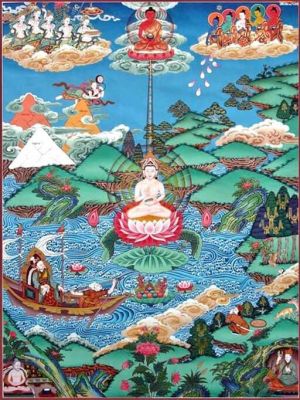Ngondro - Panorama of Buddhist Teachings
Red Floral SplendourThe Tibetan term Ngöndro refers to the preliminary, preparatory, or foundational practices or disciplines (Sanskrit: sādhanā) common to all four schools of Tibetan Buddhism.
The term ngöndro literally denotes meanings in the range of “something that goes before, something which precedes.” The preliminary practices establish the foundation for the more advanced Vajrayana sādhanā which are held to engender realization and the embodiment of Dzogchen.
Nevertheless, Vajrayana masters are careful to point out that “foundational” does not mean “lesser”, that the practice of Ngöndro is a complete and sufficient practice of the spiritual path, and that it can take the practitioner all the way to full enlightenment.
In addition to what is generally denoted by the term ngöndro, preparatory practices, may also be prescribed for senior and advanced sadhana as the preparatory practice for “cutting through to primordial purity.”
In general the preliminary practices are divided into two sections or kinds: the first are the common or ordinary kind of preliminary practices, and the second are the special or extraordinary kind of preliminaries.
The common or ordinary preliminaries consists of a series of deep reflections or contemplations on the following four topics:
the freedoms and advantages of precious human rebirth
the truth of impermanence and change
the workings of karma
the suffering of living beings within samsara
The above four contemplations are sometimes referred to as “the four reminders” or “the four mind-changers” or “the four thoughts which turn the mind towards Dharma.”
Additional reflections may be included in the specific instructions on the outer preliminaries within different lineages, but the above four topics are the main reflections.
The special or extraordinary kind of preliminaries consist of :
taking of refuge in the three roots (that is, in the Three Jewels, also called the Three Treasures, Three Refuges, Precious Triad, or most commonly the Triple Gem) in conjunction with the performance of prostrations (purifying pride) cultivation of bodhicitta (purifying jealousy). (In some formulations this is included under 1.)
recitations of Vajrasattva’s hundred-syllable mantra (purifying hatred/aversion)
mandala offerings (purifying attachment)
guru yoga practices (purifying delusion)
These practices purify negative deeds and accumulate merit. Traditionally ngöndro practice is done for the enlightenment of the spiritual aspirant and for the benefit of all sentient beings. That is, the merit of doing the practices is dedicated to all sentient beings.
Ngöndro is an essential practice of all schools of Tibetan Buddhism as well as the indigenous Bön tradition. Each of the four main schools of Tibetan Buddhism—Gelug, Kagyu, Nyingma and Sakya—have variations as to the order of the preliminaries, the refuge trees visualized, the lineage gurus and deities invoked, prayers etc.
Despite these differences, all Ngöndro practices have as their goal the enlightenment of the practitioner so that he/she may be of the greatest benefit to all sentient beings, that is, the cultivation of bodhichitta.
While some novices may feel that the Ngöndro are somehow “lesser” than various tantric practices, they are a complete path to enlightenment in and of themselves. The renowned Lama Patrul Rinpoche (1808–1887) is said to have practiced the Longchen Nyingthig Ngöndro repeatedly throughout his life.
Sources
Gethin, Rupert (1998), Foundations of Buddhism, Oxford University Press
Khandro Rinpoche (2003), This Precious Life, Shambala
Patrul Rinpoche (1998), The Words of My Perfect Teacher, Altamira
Sogyal Rinpoche (2009), The Tibetan Book of Living and Dying, Harper Collins, Kindle Edition
Tulku Urgyen Rinpoche; Trulshik Adeu Rinpoche (2011), Skillful Grace: Tara Practice for Our Times, Random House
Further reading
Blofeld, John. The Tantric Mysticism of Tibet. Prajna Press, Boulder, Colorado, 1982.
Chagdud Tulku Rinpoche. Ngondro Commentary: Instructions for the Concise Preliminary Practices of the New Treasure of Dudjom. Padma Publishing, Junction City, CA., 1995.
Jamgon Kongtrul. (trans. by Judith Hanson). The Torch of Certainty. Shambhala Publications, Boston 1994. (This is a classic text by the great 19th century polymath, Jamgon Kongtrul the Great, with contemporary commentaries by Kalu Rinpoche, Deshung Rinpoche, and Chögyam Trungpa Rinpoche.)
Kalu Rinpoche. The Foundations of Tibetan Buddhism: The Gem Ornament of Manifold Oral Instructions Which Benefits Each and Everyone Appropriately. Snow Lion Publications, Ithaca, New York, 1999.
Patrul Rinpoche, “Words of My Perfect Teacher”, translated by the Padmakara Translation Group, Shambhala Publications, Boston, 1994.
Khenpo Ngawang Pelzang, “A Guide to the Words of My Perfect Teacher” translated by the Padmakara Translation Group, Shambhala Publications, Boston, 2004.
Dilgo Khytentse Rinpoche, “The Excellent Path to Enlightenment” translated by the Padmakara Translation Group, Snow Lion Publications, Ithaca NY, 1996.
Jigme Lingpa, “Dzogchen – Innermost Essence Preliminary Practice” translated by Tulku Thondup, ISBN 81-85102-19-8, 1982/2002.
Third Dzogchen Rinpoche, “Great Perfection: Outer and Inner Preliminaries” (Khandro Nyingtik) translated by Cortland Dahl, ISBN 1-55939-285-1, 2008.
Entrance to the Great Perfection: A Guide to the Dzogchen preliminary Practices, translated by Cortland Dahl, ISBN 978-1-55939-339-3.
Source
[[1]]
